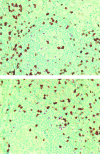High ratio of interfollicular CD8/FOXP3-positive regulatory T cells is associated with a high FLIPI index and poor overall survival in follicular lymphoma
- PMID: 22993621
- PMCID: PMC3446740
- DOI: 10.3892/etm.2010.146
High ratio of interfollicular CD8/FOXP3-positive regulatory T cells is associated with a high FLIPI index and poor overall survival in follicular lymphoma
Abstract
Several studies have highlighted the importance of the microenvironment in the behaviour of follicular lymphoma (FL). We conducted an immunohistochemical analysis to assess the role of different cell subpopulations, i.e. CD8, CD68 and forkhead box protein P3 (FOXP3)-positive regulatory T cells (Treg cells) in 84 lymph nodes of 58 patients with FL (58 at diagnosis, 26 at relapse). Since the overall effect of Tregs is considered to depend on their number in relation to CD8(+) effector T cells, we determined the corresponding ratio for each patient and correlated the results with clinical parameters. The interfollicular CD8/FOXP3(+) cell ratio was significantly higher in patients with histological grade 3 tumours (2.04 vs. 1.63) and with a high risk FLIPI index (2.99 vs. 1.53) compared to those with grade 1-2 tumours or a low-intermediate FLIPI index. Similar results were obtained for the follicular CD8(+)/FOXP3(+) cell ratio. The interfollicular CD8/FOXP3 ratio was found to have prognostic value [a 5-year overall survival (OS) of 82 vs. 59% for a ratio of ±1.68]. In addition, an interfollicular FOXP3(+) cell number of more than 86 cells/mm(2) was correlated with a more favourable outcome (p=0.03). When patients at diagnosis and relapse were compared, a significant difference (p=0.05) in the localization (interfollicular vs. intrafollicular) of FOXP3(+) cells was observed. The CD8/FOXP3 ratio in the interfollicular areas was significantly different (1.66 at diagnosis vs. 2.2 at relapse, p=0.05). The presence of a small number of FOXP3(+) cells with a high CD8/FOXP3 ratio is probably the indicator of an active immune response during tumour development, with lymphoma cells acting as targets or bystanders.
Figures



References
-
- Tsujimoto Y, Cossman J, Jaffe E, Croce CM. Involvement of the bcl-2 gene in human follicular lymphoma. Sciences. 1985;228:1440–1443. - PubMed
-
- Solal-Céligny P, Roy P, Colombat P, White J, Armitage JO, Arranz-Saez R, Au WY, Bellei M, Brice P, Caballero D, Coiffier B, Conde-Garcia E, Doyen C, Federico M, Fisher RI, Garcia-Conde JF, Guglielmi C, Hagenbeek A, Haïoun C, LeBlanc M, Lister AT, Lopez-Guillermo A, McLaughlin P, Milpied N, Morel P, Mounier N, Proctor SJ, Rohatiner A, Smith P, Soubeyran P, Tilly H, Vitolo U, Zinzani PL, Zucca E, Montserrat E. Follicular Lymphoma International Prognostic Index. Blood. 2004;104:1258–1265. - PubMed
-
- Lossos IS, Levy R. Higher-grade transformation of follicle center lymphoma is associated with somatic mutation of 5′ noncoding regulatory region of Bcl-6 gene. Blood. 2000;96:635–639. - PubMed
-
- Küppers R. Prognosis in follicular lymphoma – it’s in the microenvironment. N Engl J Med. 2004;351:2152–2153. - PubMed
LinkOut - more resources
Full Text Sources
Research Materials
